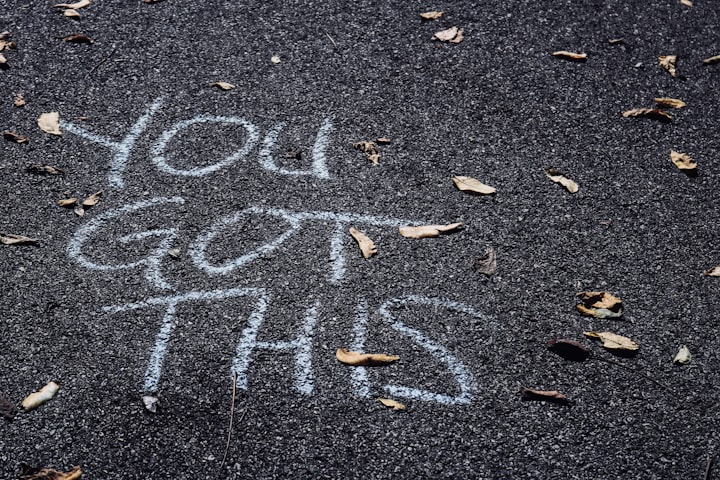Panic! 5 MORE ways to Alleviate Panic Attack Symptoms and Anxiety
Anxiety sucks, but it can suck a little less.

About a year ago I published a piece on Vocal, Panic! 5 ways to Alleviate Panic Attack Symptoms and Tips on Dealing with their Aftermath, and it became my most read piece on the site, eclipsing my short stories, poetry, and memoirs. I had started it in an attempt to write something that would qualify as "click bait," and found myself hours later, old notebooks and folders of print-outs from years of personal research fanned around me, trying to convey just what Anxiety and Panic Attacks were, and things I had found that helped. I had to narrow it down to just 5 bullet points, so I combined, connected, and coalesced as much information as I could and came up with my list: Ride it out, Move, Breathe, Mantras, and Recovering. I have only re-read it a few times, but in doing so realized just how much I had left out about Anxiety in general in my effort to focus specifically on Panic Attacks.
In this "part 2" of my Tips for Anxiety Series, I want to share more of my personal research and experiences, delve deeper into things that I didn't in my first article, and continue to share information I have been given and have been collecting about Anxiety. As with my first article, I am writing this with the purpose of helping even just one person. Helping someone feel less alone, showing them something they haven't tried before, concepts that can be life-changing. It is also for the loved ones of those who suffer from Anxiety, to provide some insight, food for thought, and the knowledge that people who suffer from mental illness' are more than a check-list of symptoms.

1) Release Energy. The dreaded physical side effects of anxiety and panic attacks; the sobbing, shaking, curling into yourself, rocking, etc. These physical manifestations of anxiety and panic is your brain telling your body that you have excess energy that needs to be released. Crying, for instance, should not be seen as "I can't stop crying, I'm spiraling out of control, what is happening to me?" It should be seen as a release. From my last article where I talk about moving, I would like to add that physical movement, beyond grounding yourself during a panic attack, is a release of pent-up energy that is too much for your body to handle. People with anxiety spend so much time stuffing their feelings down, and feeling like they are too much, that we forget that releasing energy is normal and that for us, it is essential.
Start small. Put on music and just dance. Jump up and down, spin in circles, sing along, flail your arms and just DANCE. I, personally, hula hoop, and dancing with my hoop for a half hour to grimy dubstep every day has wildly changed my energy levels. I find I shake less on days that I dance, I don't chew on my nails or lip as much, and I even smoke less cigarettes. I don't find myself stewing and thinking "I need something to make this feeling go away" as much. Small can be anything, jogging down your road, to your mailbox, hopping on a bike and pedaling down a grassy hill, punching all the pillows on your bed and picturing them all having the face of that jerk that cut you off earlier on your way home. Instead of furthering the feeling of being "out of control," let your physical movement of your choice be a healthy release of energy.

2) The Anxiety Triangle. When you feel your stress begin peaking into Anxiety and a Panic Attack may be on the horizon, try this. Picture a triangle in your head: one point says "feeling," one point says "thinking" and the third says "acting." You can start at any point, there is no correct way to do this exercise.
You can start with the feeling point, "I am feeling anxious, what am I thinking about that is making me anxious, and how am I acting in response to this?" You can start with the acting point, "I am driving dangerously and yelling at other drivers, I am acting this way because I am thinking about my to-do list and I am feeling guilty, anxious, and out-of-control that I didn't get to everything on it." Or you can start with the thinking point, "I am thinking about things I didn't do or haven't gotten to yet, and because of these thoughts I am feeling anxious and that I am coming undone, and in response to this I am acting (or reacting) with anger and fear, by yelling and smashing my taillight with a well-placed kick of my boot."
This exercise works in two neat ways: one, it slows down the debilitating negative cyclical thinking that comes with anxiety and panic and keeps you in the moment, and two, it can be used in pretty much any situation and is not restricted to Anxiety. It can be used after a panic attack, as a reflection tool to figure out triggers, to delve into feelings that you didn't realize you were having, and to remind yourself that you are NOT crazy, there is an answer to behaviors/actions, and maybe you can identify it using this exercise. It can be used as you are practicing your deep belly-breathing and reciting your mantras, as a type of self-guided meditation, to check in with yourself when you aren't having an acute anxiety attack. If a negative thought intrudes on your meditative breathing, let it stay for a moment, and try taking that negative thought through the triangle before letting it go and returning to the "here and now."

3) Boundaries. You know what triggers you; social events, leaving the house, checking your email, coworkers, seeing a relative who talks non-stop. Whatever your triggers are, you can set boundaries for yourself (and for others) that can simultaneously help you and your anxiety, and help others to understand it. For example, I have realized that certain topics of conversation are extremely triggering and cause me a great deal of stress and panic, even when talking to people who I am close to. One day I decided to shout "EJECT!" at my mother while driving in the car. It startled her, obviously, because in her mind we weren't talking about anything that she considered "anxiety producing." In the past I would have gotten upset, defensive, started acting like a surly 13 year-old, and shut down. My uncharacteristic outburst caused my mother to pause and after a few moments ask, "what?" I took a breath (from the belly, no chest breathing here), and said "this [specific thing] has been giving me a lot of anxiety and causing me a great deal of stress lately, I would rather not talk about it, can we talk about something else?" My still mildly confused mother said "okay, sure" and we changed the subject. I was floored. What a different outcome this was than angrily blurting out all the reasons I didn't want to talk about this particular thing, not even sure myself of some of them, and resulting in an argument and hurt feelings. In less than two minutes my mother and I, with my use of the word "eject," found an entirely new way to communicate.
Now, you can't go around yelling "eject" at everyone (well, I mean you can, you do you), but you can use similar concepts to create the boundaries you need in order to reign in anxiety and put a damper on panic attacks. People who are close friends and family may be receptive to an index card with a list of "things I would love to talk about" (start positive), and on the back, write a few things you would rather not talk about right now (I call it "not the time or place" side of the card). I was pleasantly surprised the first time I used this. I find that humor defuses tension and it actually can become a little game if you have a few people who catch others with a "hey! that's on the off limits list!" In a more professional setting, with coworkers or you are in a social situation with people you don't know very well, if a topic comes up that you don't want to talk about because it will cause you stress, try and steer the conversation away from it by asking the person you are talking to about themselves, and gently move away from the topic. This last one I know sounds a little difficult, but it leads into #4:

4) Tell Your Story. How many times have you tried to explain what anxiety is to someone instead of what anxiety feels like? Instead of pulling up the Wikipedia page for Panic Attacks, or lugging the DSM-V down off a shelf to flip to the earmarked "Generalized Anxiety Disorder" page, try actually explaining how you feel. It may surprise you how different the outcome is when you tell your partner, "my hands are sweaty, I feel like I can't breathe, and I feel like you are upset with me and don't want to deal with me," instead of "I'm anxious," when they ask you "what's wrong?" Or if a coworker says "you seem to be upset a lot this week," while you are having a not-so-great week; instead of your go-to "I'm fine, just stressed," try saying "I'm having trouble keeping my work and personal life separate this week." You don't need to go into detail, you don't even need to bring up the words anxiety or stress, because there's a 90% chance the coworker you just said that to has had days and weeks like that too, and they might not have an anxiety disorder or experience panic attacks, but I guarantee they remember the discomfort that came with their time in anxiety purgatory.
Reframing terms like Anxiety and Depression like this, pushing aside the clinical terms and over-intellectualizing bullet pointed lists, can open up channels of communication and understanding you might be unaware of. Feelings are not an open topic of conversations for a lot of cultures, families, and society in general, but to pretend we can get rid of or ignore them is ridiculous and we are burning out as a society because of it. If people start "telling their story," telling people how they feel, maybe that will be the start of reconnecting people with people, instead of being labeled as "depressed," "someone with anxiety," or "someone who suffers from panic attacks."

5) The Letting Go. If you are like me, you have been throwing yourself pity-parties for years; "nobody likes me I might as well go eat worms" pity-parties after failed attempts to talk to a friend, a sibling, a partner, even a therapist, to try and make them understand what Anxiety is, what Panic Attacks are. As it says in the Serenity Prayer; "accept the things I cannot change, courage to change the things I can, and wisdom to know the difference." I have come to accept what most people suffering from any mental illness will have to; some people in your life might not ever get it. And you will drive yourself crazy if you don't realize that you are no one else but you, and no amount of empathy, metaphors, or creative ideas can turn you into someone else, can restructure you, contort you, to insert yourself temporarily into someone's brain so you finally have the satisfaction of hearing their ah-ha moment: "oh, THIS is what you meant." It just isn't going to happen. And the perceived lack of control that most anxiety and panic attack sufferers face every single second of every single day seems to comes true, and it is a real lack of control. But that's okay. You can't control everything, and most times it feels like you can't control anything, but in "letting go," you will find that there exists a certain calm that comes with this, a secret you have; I have control over what I choose to let go.

Whoever you are reading this, you are not alone, and if you do struggle with Anxiety, Panic Attacks, or Depression, I urge you to seek help. Talk therapy has done wonders for me, although I will include the disclaimer from my last article, I've had over 10 therapists and liked 4. They don't take it personally if you don't connect. Medication can be useful in the short term, but without finding the root of your Anxiety, it will always be a band-aid on an infection. I hope whoever is reading took something away from this, even a tiny nugget of information stored away for later. We can help each other and our loved ones by destigmatizing mental illness, learning about them, and coming together to support one another. Thank you for reading.
About the Creator
Carly Doyle
Writer, Librarian, Researcher, Activist. I could keep listing things but, hey, why don't you just take a gander at my writing?






Comments
There are no comments for this story
Be the first to respond and start the conversation.